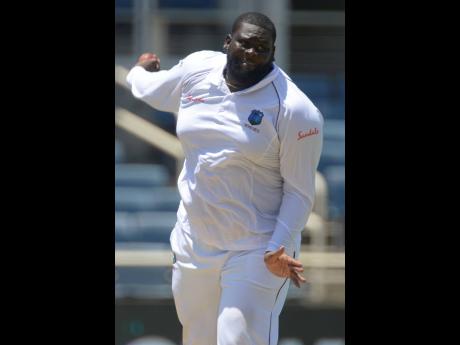Weighing up Cornwall’s Windies status
The elevation of burly Antiguan all-rounder Rahkeem Cornwall to the status of senior Windies Test cricketer has been met with some trepidation by some regional cricket fans and pundits. The long-standing scepticism about Cornwall playing international cricket is based on the limited notion that he is simply too fat, immobile, not athletic, and, theoretically, will inevitably make him a liability at the batting crease, and even more so, in the field. It has even been posited that Cornwall just does not have the look of an international cricketer.
Amid that quiet storm, the 26-year-old, 6’5”, 315lb man has steadily progressed as one of the region’s top all-rounder, scoring four centuries and four half-centuries in List A cricket, as well as one century and 13 half-centuries in first-class cricket. Even more impressively, Cornwall has taken 273 first-class wickets at 23.8 each to conspicuously outshine his regional counterparts in the two key components of the game.
He, therefore, earned his debut spot in the Windies team in the recent home series against India in August, when he performed no worse than his trimmer, fitter, more mobile teammates. Cornwall retained his place in the team for the ongoing tour of India, where he was brilliant in his man-of-the-match 10-wicket haul performance, leading the Windies to an emphatic third-day victory in the one-off Test against Afghanistan. In the process, he became the first West Indian spinner to take 10 wickets in a Test match on the subcontinent.
Credible case for disqualification
Based on his performances before and subsequent to his Test selection, any attempt at, or even the thought of, disqualifying Cornwall from playing international cricket based on his size, weight, and immobility is tantamount to discrimination. A credible case for his disqualification from playing international cricket can only be made based on eligibility and/ or performance. Not only has Cornwall earned his place in this still-poor Windies team, but he has now consolidated his status as a Test player.
Slow bowling, by its nature, is more technical and cerebral a skill than it is physical. A few jogged steps precede each delivery. Six deliveries are followed by a rest on the fine leg boundary or in the slip cordon. After a four- or five-over spell, the rest is extended. In his turn at bat, while it is unlikely that Cornwall will take many sharp singles, he has the proven strength and technique to compensate for that weakness with his power hitting.
Of course, the enigma of Rahkeem Cornwall could only thrive in a team as poor as the Windies. He surely could not get into Australia, India, England or any other top international teams. It is, however, not Cornwall’s fault that the standard of Windies cricket is so poor at the moment. To his credit, he has honed his skills, worked on his craft, and persisted to the point where his total assets to the team now outweigh his liabilities in what is still a performance-based business.
The journey of ‘Jimbo’ Cornwall should also serve as a timely reminder to the regional cricket authorities of how low the standards have fallen. If Cornwall was around in the glory days of the late ’70s, ’80s, and early ’90s when West Indians were kings of cricket, he probably would not make his high-school or village team. These are, however, so not the glory days, and the reality is that Rahkeem Cornwall is, at the moment, among the region’s best-performing all-rounders, despite his physical limitations, limitations which ought not to be used against him as long as he continues to outperform his peers.

